Did you know that improper transport of ladders and large items can lead to hefty fines and penalties?
Many regions have specific laws governing the safe securing of oversized cargo on vehicles.
For example, if a ladder isn’t tightly fastened and accidentally falls off, you could be fined or even held responsible for damages or injuries resulting from the incident. In some areas, penalties can include fines for each unsecured load, and in severe cases, reckless endangerment charges may apply.
Not only does securing large items reduce the risk of fines, but it also helps prevent accidents, injuries, and damage to both your vehicle and others on the road. Taking a few extra minutes to follow best practices and ensure your load complies with local regulations can save you from facing legal repercussions and help keep everyone on the road safer.
Protruding items
Laws on objects protruding from vehicles or trucks are designed to ensure road safety and often specify the allowable overhang limits at both the front and rear of a vehicle.

Generally, most states in the U.S. limit rear overhangs to 4 feetbeyond the back of the vehicle, while front overhangs are usually limited to 3 feet. However, regulations can vary widely by state or country.
When cargo exceeds these limits, drivers are often required to mark the extended portion with a red flag during the day and a red or amber light at night.
In addition to length restrictions, some jurisdictions require multiple markers if the load extends significantly to the sides, especially for wider items. Compliance with these regulations helps prevent accidents by ensuring that other drivers can see and avoid potentially hazardous overhangs.
Always consult your local Department of Motor Vehicles (DMV) or transportation authority to confirm specific guidelines in your area, as laws may include additional conditions for oversized or specialized loads.
Regulations about protruding objects
In the U.S., the Federal Motor Carrier Safety Administration (FMCSA) mandates that cargo must be secured to prevent shifting or falling, with particular attention to items that extend beyond the vehicle’s dimensions.

According to FMCSA regulations, cargo should be immobilized by using straps, ropes, or chains, and in cases of items like ladders or long pipes, tiedowns must be used to secure both the front and back of the protruding item.
Many states also have their own regulations on securing cargo that extends beyond the vehicle.
For example, California’s Vehicle Code (Section 23114) requires that any item extending more than 4 feet from the rear must be marked with a visible flag or light at night, and that all items be properly tied down. Failure to secure a load or mark an extended item can result in fines and liability in case of an accident.
Similarly, many local laws require multiple tiedown points and recommend regular checks during the journey to ensure that no movement or shifting occurs.
In addition, the North American Cargo Securement Standard Model Regulations, which the U.S. and Canada follow, specify best practices for securing cargo, including the need to prevent load shift and ensuring all tiedowns are strong enough to withstand vehicle motion and external forces. Non-compliance with these regulations may lead to penalties and liability for damages or injuries caused by improperly secured loads.
Always refer to both federal and local guidelines to ensure compliance, as specific rules may vary.
Red flag rules
In many regions, red flags or markers are required on items that extend beyond a certain length from the vehicle. Here’s an overview of the typical rules:
- Length Requirement for Red Flags: Generally, if cargo extends more than four feet past the rear of a vehicle, it must be marked with a visible red flag. In some cases, the overhang limit is three feet in front, four inches on the side, and four feet in the rear, depending on local regulations.
- Flag Size and Color: The red flag needs to be at least 12 inches square (some areas require 18 inches) and bright red or fluorescent orange for maximum visibility. During daylight hours, this flag should be securely fastened to the end of the item that overhangs.
- Nighttime Requirements: At night or in low-visibility conditions, many jurisdictions require a red or orange light in addition to the flag. This helps ensure the item is visible to other drivers from a safe distance.
- Placement: Place the flag or light at the end of the longest overhanging portion to make sure it’s visible from multiple angles. For items that extend both to the side and rear, you may need additional flags to mark each end.
These regulations can vary by state or country, so it’s a good idea to check your local Department of Motor Vehicles (DMV) or transportation authority for specific guidelines. Following these rules helps keep you compliant and ensures other drivers are alerted to potential hazards from oversized cargo.
Oversize items
Here are examples of items that are often too long to safely carry on a standard vehicle without careful consideration and proper securing equipment:
- Ladders – Extension ladders, especially, can easily exceed vehicle length.
- Pipes – PVC, steel, or metal pipes, commonly used in plumbing and construction, can be challenging to transport.
- Wooden Planks and Lumber – Boards for construction, such as 2x4s and longer beams, often exceed safe limits for standard cars or trucks.
- Construction Beams – Steel or wooden beams, including I-beams, are usually longer than most vehicle beds.
- Large Metal Rods or Rebar – Used in construction and often exceeding practical vehicle lengths.
- Kayaks and Canoes – Recreational items like kayaks can extend significantly over vehicle roofs, especially for sedans or smaller cars.
- Scaffolding Sections – While often collapsible, full sections can still extend beyond a vehicle’s capacity.
- Sheet Materials – Large sheets of drywall, plywood, or metal sheeting can protrude beyond vehicle beds or roofs.
- Long Gardening or Landscaping Tools – Polesaws, long rakes, and other tools are difficult to fit in small vehicles.
Checking and Rechecking Your Setup
Even the most secure setups should be rechecked before and during the journey. Stops along the route provide an opportunity to ensure nothing has shifted, straps remain tight, and padding hasn’t worn or shifted. Additionally, consider inspecting the ladder and equipment for any wear or damage before securing them, as faulty gear can cause unexpected issues during transport.
Are you a freight broker? We can help you get new shipper leads with active loads…






